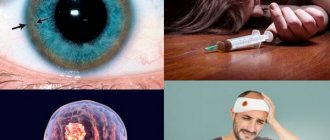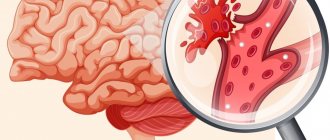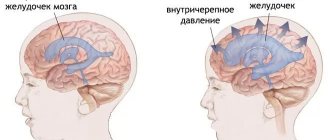Publication date: February 6, 2020
Endogenous (circular) depression is a mental disorder in which the patient develops a depressed state, melancholy, unmotivated anxiety and insomnia. In severe cases, thoughts of suicide appear. This disorder is more often diagnosed in women. For endogenous depression, treatment should be carried out by a qualified psychiatrist. The patient cannot cope with this disease on his own.
Somatogenic depression
The somatogenic form of depression (from the Latin soma, somatos - “body”) is also called symptomatic, since it is based on another disease. This is either a pathology of the brain - a tumor, stroke, traumatic brain injury; or severe somatic diseases - diabetes mellitus, ischemic heart disease, bronchial asthma.
With this type of depression, treatment is aimed at the underlying disease, which became the trigger for the mental disorder. Patients with somatogenic depression are observed by neurologists, therapists, and oncologists. Psychiatrists and psychotherapists play a supporting role.
Psychogenic and endogenous types of depression often come to the attention of psychiatrists and psychotherapists.
Reactive depression: nature of occurrence
The emergence of full-fledged RD is observed when two key factors are combined:
- Helplessness . The patient believes that he cannot stop the effect of the traumatic factor or eliminate/change the negative consequences caused by it. At the same time, it is important to clarify that only the subjective assessment of the situation on the part of the patient matters, and not the objective possibility of somehow influencing the external factor.
- Weakness of character . Reactive depression is more susceptible to weak-willed individuals who are initially predisposed to pessimization of any negative events and who do not know how, figuratively speaking, to “withstand the blow.” AD is not typical for so-called “strong personalities” - with strong internal experiences, they more often suffer from hidden depression.
It is noteworthy that the nature of the traumatic external factor does not play any role in the occurrence of RD in a particular patient. Equally, it can be either the death of a close relative or someone’s quickly cast condemning glance - only the interpretation of this event by the patient himself matters.
What is endogenous depression
Endogenous depression is a type of depression that appears in 5–7% of all cases of depression. The reasons for its occurrence have not yet been precisely described. Most scientists agree on the leading role of genetic predisposition, which consists in the inheritance of pathological genes. These genes are responsible for a person’s increased emotional sensitivity to any, even minor, stress factors.
Thus, if we consider the two main types of depression, the differences between psychogenic depression and endogenous depression are the reasons for their development. Depending on the cause of depression, all other, more specific differences are formed.
Symptoms
All symptoms and signs characteristic of RD can be divided into two main groups: general and specific.
General signs
General symptoms of AD are identical to any other depressive disorder:
- prolonged lack of good mood;
- loss of the ability to enjoy pleasant events or news;
- negativism of reasoning and assessments of the surrounding reality;
- decreased self-esteem, increased criticism of one’s talents and abilities;
- loss of internal motivation to achieve life goals, desires and generally carry out any activity;
- chronic fatigue, drowsiness, constant poor health;
- somatic diseases (cardiovascular, gastrointestinal, etc.).
Specific signs
Specific symptoms characteristic only of RD include:
- Premonition of trouble . Patients live with a constant feeling of imminent continuation or further development of a traumatic situation, even if it has already completely exhausted itself in essence. Some patients simply “anticipate” the approaching onset of new troubles, due to their personal “worthlessness” or “failure.”
- The Infinity of Trauma Memories . In conversations with loved ones, a patient suffering from typical reactive depression constantly returns to the situation that traumatized him, assessing what happened from new points of view, imagining other options for resolving the problem, etc. Almost always, patients themselves, however, distract yourself and stop indulging in negative thoughts again and again they cannot remember.
- Worldview conclusions . At later stages of development of RD, patients delve into philosophical discussions that “this could happen to anyone and no one is immune from it” or embark on lengthy discussions about the injustice of the structure of society and the world as a whole. Typically, such philosophizing is of a compensatory nature: patients in this way try to reduce the severity of their experiences and reduce the subjective significance of the traumatic event.
Symptoms of psychogenic and endogenous depression
Typical manifestations of any type of depression are the so-called depressive triad:
- Depression itself is low mood, despondency, despondency;
- Mental retardation - lethargy, passivity, taciturnity, lack of emotions, loss of appetite, lack of initiative. All thoughts revolve around the same worries, which makes it difficult for patients to concentrate on something new;
- Motor retardation - slowness, patients spend a long time in one position (usually lying down), answer questions after a pause, speak slowly.
With psychogenic depression, mental and motor retardation are less pronounced than with endogenous depression. Therefore, it is difficult to see the classic depressive triad with her.
The main features that allow one to suspect a reactive (psychogenic) form of depression are:
- A clear temporal and cause-and-effect relationship with a severe traumatic event. The first symptoms may appear either immediately after a stressful event or after some time (several weeks or months);
- Exacerbations are associated with the repetition of situations that relate to psychotrauma - deterioration of well-being in a certain environment, in connection with a certain date or person;
- Feeling worse in the evening;
- When the effect of the psychotraumatic factor ends - the person leaves the stressful situation or changes his attitude towards it with the help of psychotherapy, the symptoms of depression regress.
Sometimes psychogenic depression occurs without an external cause, which makes it similar to endogenous depression. In such cases, the reason was invisible to others and lay in the person’s internal experiences, which accumulated under the influence of external factors. Only an experienced specialist can figure out what was the real cause of depression and prescribe treatment.
Endogenous depression manifests itself as the classic depressive triad. The main difference from psychogenic disorders is the absence of previous psychotrauma.
The first symptoms of endogenous depression can appear both in adolescence and at 40–50 years of age. The difficulty of diagnosis lies in the fact that depending on the age of onset of the disease and the severity of neuropsychiatric disorders, the manifestations differ greatly. None of the symptoms of the depressive triad are mandatory, although an experienced doctor will suspect depression based on the patient’s appearance, features of his thinking and behavior.
Depression today, how to avoid it
Depression, ICD-10 code F32 – persistent decrease in mood for at least 2 weeks. However, it is always necessary to take into account the presence of existing concomitant diseases of a person, the medications he is taking, and the individual parameters of the formation of the body. Therefore, this period is always conditional. The main criterion of the disease is a decrease in quality of life. Influence on the external and internal life of the patient. As long as the body and psyche cope with the condition on their own, the help of specialists is not needed.
Treatment of depression - modern methods of restorative medicine 8.
How does depression manifest itself?
Depression often goes hand in hand with anxiety, sleep disturbances and general weakness. It occurs in response to unfavorable life circumstances or manifests itself as a result of a violation of brain biochemistry. There are also certain forms of depression that can be difficult to recognize. For example, somatization or postpartum depression, they are disguised as other diseases. These features require careful medical diagnosis and a completely different approach to treatment.
Depression is always associated with loss of energy. Be it the body’s struggle with a serious illness, a severe shock, or long-term difficult life circumstances from which a person cannot get out on his own.
In today's world, only a few manage to avoid depression. Depression affects everyone to one degree or another. But does everyone always need treatment?
How common is depression?
Doctors of various specialties often encounter depressive symptoms in their clients. Human emotions are a very mobile area of the psyche. But at times a person seems to be frozen on one emotional tone and is unable to return to his previous level.
Any statistics on depression will not reflect its true prevalence, since any disease, one way or another, upsets us and spoils our mood. This means that neurotic depressive symptoms will be added to the main disease. The pain will become more painful, the pressure will jump more strongly, and the heart will beat faster than this is reflected by objective changes in the organs. All this brings confusion to the therapeutic diagnosis of diseases. Doctors, and even patients themselves, are surprised that the prescribed treatment does not help as much as it should. And this will cause even more anxiety for the sick person.
At the same time, competent psychological assistance can almost completely relieve pain even in patients with advanced cancer or lower blood pressure without resorting to chemicals. All this indicates the significant influence of the subjective factor of perception of the symptoms of the disease and reaction to the surrounding reality.
Main Differences
Despite the similarity of manifestations, each type of depression has characteristic features, symptoms and treatment algorithms.
For clarity, the main differences between psychogenic depression and endogenous depression are presented in table form:
| Sign | Psychogenic depression | Endogenous depression |
| Reason for development | Psychotrauma | For no apparent reason |
| Typical symptoms | Mental or physical retardation is mild or absent | Classic depressive triad |
| Experiences | Reflect the content of a traumatic situation - dismissal, loss of a loved one, conflict in relationships | They do not correspond to the real problems of a person. For example, a healthy person begins to think that he is terminally ill |
| Exacerbations | Connection with psychotrauma | Sometimes associated with psychological trauma |
| Daily mood swings | Worse in the evening | Mood is worse in the morning |
| Main method of treatment | Psychotherapy | Drug treatment |
There is a risk of suicide attempts in both psychogenic and endogenous forms of depression.
Therefore, it is important to notice the first signs of the disease as early as possible and immediately consult a specialist doctor. Depression is not just a low mood. This is a serious mental illness, from which it is difficult to “get out” on your own. As with any pathology, the effectiveness of treatment directly depends on the correctness of the diagnosis. It is important not to self-medicate and not to let the disease take its course, but to promptly seek help from a specialist who has experience in working with this disease.
Stages of development
In its development, reactive depression goes through 3 main stages:
- Stress or shock . The patient is in a state of severe nervous shock, sometimes reaching shock, respiratory neurosis or cataleptic stupor. For some time, he is completely deprived of the ability to think sensibly, is almost completely disconnected from the outside world and painfully replays what happened in his head. This condition rarely lasts longer than 3-5 days.
- Anxiety and worry . The severity of the experience decreases, giving way to constant anxiety and concern, which the patient cannot explain or justify from a rational point of view. At this stage of RD, patients are in constant, although not always conscious, anticipation of the continuation of the traumatic situation, its deepening and worsening. The state of anxiety may persist for 1-2 months.
- Depression and apathy . In fact, reactive depression itself sets in, which without proper therapy leads to such serious consequences as somatic diseases, intellectual inhibition, loss of ability to work, and even suicide. This transition does not occur abruptly - as a rule, anxiety turns into depression over the course of several weeks.











